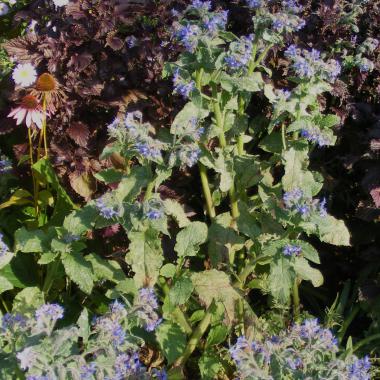


Borage blue flowered seeds (Starflower)
Borago officinalis

Borage is an annual herb, native to the Middle East and introduced to the UK by the Romans.
It makes a tall bushy plant — up to 80 cm — and can become floppy later in the season
due to the weight of flowers and foliage.
The leaves are rough and hairy with a cucumber flavour, so it is the younger, smaller leaves
which are used in recipes.
The herb does need to be used fresh as it loses its flavour when dried.
The leaves are commonly used in cooking in parts of Europe such as Germany, Greece and parts of Spain and Italy,
where they are made into sauces, soups and pasta flavourings.
In the UK it is more often grown for its flowers.
From June through until the first frosts, it produces a continuous succession of small vibrant blue flowers,
interspersed occasionally with some pale pink ones.
The flowers are used as a colourful garnish on salads and dips, and also floated onto summer soups, cold drinks and cocktails.
The most popular and traditional use is their addition to Pimms, to add a honeyed cucumber flavour and lots of colour.
Borage leaves and flowers also make a delicious addition to cider punch …
The individual flowers can be preserved for winter use by freezing them in ice cubes.
As well as being an attractive flowering plant for the herb garden, borage is very useful planted with fruit
and vegetables where the flowers attract bees and other pollinators,
which increases crop yields for beans, strawberries, tomatoes etc.
Borage is also cultivated commercially for the oil extracted from its seeds.
Borage seed oil contains high levels of gamma-linolenic acid (GLA) which
is often sold under the name starflower oil as a health supplement useful for skin disorders,
rheumatoid arthritis, high blood pressure and PMS to name but a few!
The levels of GLA are approximately twice as high as the more well known Evening Primrose oil.
Young borage leaves, with their cucumber flavour, can be used in a 50:50 ratio with parsley or coriander
in sauces for chicken and fish recipes.
Borage is at its best in sauces which require no cooking.
The South American sauce Chimichurri is traditionally served with steaks,
but by varying the herb content you can make a great alternative to accompany grilled chicken and fish.
Chimichurri
Typical Chimichurri contains parsley, oregano and lots of garlic. Borage, and indeed mint leaves, can replace some or all of the parsley to make a delicious alternative to serve with chicken and fish.
- 30 g roughly chopped parsley and young borage leaves mixed
- 15 g oregano leaves (or 2 tbs dried herb)
- 1 heaped tsp red pepper flakes
- 60 ml wine vinegar
- 1 tsp salt
- 60 ml water
- 120 ml olive oil
Add everything to the food processor except the oil and turn on to chop the herbs. Keep the motor running and slowly pour in the olive oil until it is all combined, a bit like making mayonnaise. The best taste develops if you make this a few hours before serving.